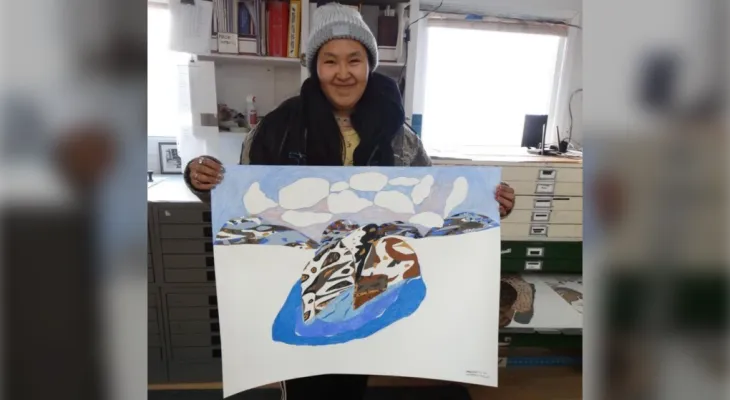Search here
Newspaper
Search here

Arab Canada News
News

Published: January 13, 2024
The story began with a very small and unequipped art studio, which drove the printmakers to open the windows for the Arctic winter to ventilate the toxic chemicals.
Now, it has become a globally known source of images and imagination that adorn the walls and tables of Canadians and art lovers around the world – as well as businesses that provide the Inuit with everything from public housing to small engine repairs.
Paulozi Kumajak, president of the West Baffin Cooperative Association, Canada’s oldest indigenous-owned art organization, celebrated its sixty-fifth anniversary this year: "We are very busy," she said. She is known in her indigenous community in Kinngait, Nevada, simply as "the cooperative," but she is better known as the first print studios that brought the Inuit vision to the world and gave Canada some of its most famous arts.
Artworks from Kinngait, formerly Cape Dorset, have appeared on postage stamps like "The Spellbound Owl" by Kinuguaq Ashivak, among others, and have been presented to ambassadors and represented Canada at major international art exhibitions such as the Venice Biennale.
Darlene White, Inuit art curator at the Winnipeg Art Gallery, which holds the largest collection of these works in the world, said, "It has been an important part of Canadian culture."
The cooperative began in 1959, as a result of efforts to improve the production, quality, and marketing of art that the Inuit had been producing for centuries. Studios like West Baffin gave Inuit creators the opportunity to move from carving to the more profitable printmaking field.
Those were tough and raw days, as printmaker Nivaksi Kofianqtuliak, who worked in the studio for 34 years, recalls.
She added: "We did not have any proper equipment." "When we used harsh chemicals, our ventilation was very poor, and we had to open windows and doors, and in January, by the time all the chemicals were done, you could see your breath." Not so anymore.
The studio – purportedly now the longest-running print shop in Canada – is equipped with the latest stone-cutting, carving, stencil, and lithography equipment, in addition to a painting studio, and houses a gallery, restaurant, and retail area within the 1000-square-meter Kinngait Cultural Centre.
Kumajik said more than 100 people work there, making it the largest employer in the town.
"Economically, we help the community; almost all the artists and printmakers translating their designs onto paper are local, many of them second or third generation.
She added: "We are happy to keep it within families," "We are trying to push it into the school system as well to ensure its continuity."
White said the art from West Baffin has changed over generations, with images rooted in traditional activities on land, ancient myths, and animal life evolving to include elements of modern Inuit life. It has also become more technically complex, gradually moving from simple silhouettes to incorporating color and perspective,
She continued: "It has become more diverse," "The subject matter is certainly shifting from wildlife lived by their ancestors to a more urban view, which is what all the youth are doing – they are not depicting hunting scenes."
Over the life of the cooperative, the art has also gained international recognition.
In 1999, then-French President Jacques Chirac traveled to Kinngait to meet artists and make purchases. White organized Inuit art exhibitions in the European principality of Monaco – attended by Prince Rainier – as well as in the Italian city of Verona.
White said, "Italians think the market focuses on art, but it was really fun to see them exploring sculptures, prints, drawings, and textiles."
White is currently preparing for a show of artist Kinngait Shuvinai Ashoona in London, England, with celebration exhibitions for the cooperative’s anniversary planned for Miami and Fredericton.
West Baffin has become a channel between life on a remote island in the Arctic and the rest of the world, with many international visitors, the latest being a delegation from South Korea.
Quvianaqtuliaq studied at the Nova Scotia College of Art and Design and worked with printmakers in Albuquerque, New Mexico.
He said: "We are worldwide now," "I look back and look around and can't believe I’m here, working with all the artists, I love my work."
Comments